Final Essay
By Lifan Yu
A. PROJECT TITLE: “Save Me From Plastics”
B. PROJECT STATEMENT OF PURPOSE:
Me and Xinran focus on an environmental problem: plastic pollution. Plastic in the ocean harm marine animals. Animals die from accidentally eating plastic pieces because they stay in their bodies and cause them diseases. Also, plastic is difficult to decompose, they stay in natural environment for a long time.
According to a recent study, humans have produced 8,300,000,000 tons of plastic waste ever since the year of 1950. However, most of these plastic wastes were not properly treated. Only 9% of them are recycled, 12% are burned. However, as much as 79% of all these wastes were dumped into landfills or thrown into the ocean.
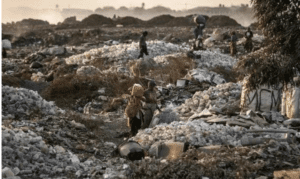
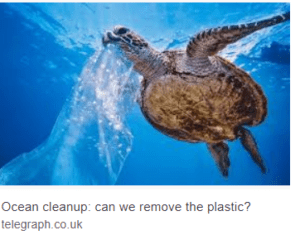
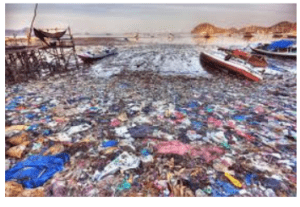
According to professor Jenna Jambeck from University of Georgia, most of these plastic wastes do not have any biodegradations. They will stay in these natural environments for hundreds or thousands of years. Not only will this harm wild animals but also lessen safe lands that we can live in.
Inspired by these, we try to design an interactive game that encourages people to use less plastic product and find ways to treat plastic wastes that do less harm to our environment. Our intended audience is people who are still not fully aware what a huge negative impact we have on our environment with all those plastic trash. We intend to raise environmental awareness, maybe people can have a more careful thought about this matter after enjoying this game and adopt a way of living with less use of plastic products.
C.PROJECT PLAN
We plan to create an interactive two-players game that raises awareness on plastic pollution and promote environmental actions.
The game screen can be projected on a wall like this:
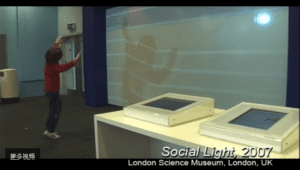
Our game screen looks like this:
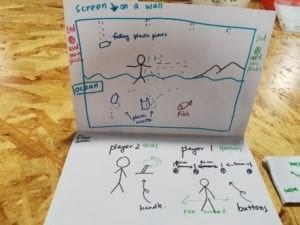
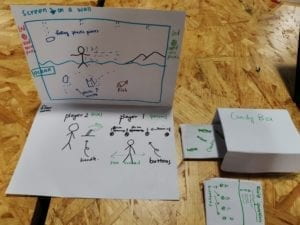
Players stand in front of this wall. One player controls the motion of a person. Another player controls the motion of a fish in the sea. Plastic products like plastic bottles will fall from above (one at a time, but they fall from random places) , representing all the tempting plastic products we encounter each day and use naturally without thinking about their impact on our environment. If the person does nothing, the products are automatically being “accepted” for use by this person and soon thrown into the sea—just like what garbage treatment people do with plastic waste—dumping them into the sea. If the person moves around and purposefully “reject” using plastic products (in this game, by blocking them), those products will disappear, representing less usage of plastic products.
The first player controls motion of the person by pushing four separately placed buttons in front of them. The person on the screen move to different places when different buttons are pushed. The player controls motions of the fish using a handle. This player tries to avoid touching all the randomly moving plastic pieces.
Whenever the person successfully rejects the usage of a plastic product, a green light beside the screen will blink. The green light has a caption on “I used less plastic product today!” When they fail to reject, a red light with a caption of “used one more plastic product” will blink.
There will be some already existing plastic pieces in the sea, but there will be more when more plastic pieces are thrown in to the sea by people. If the fish touches any pieces of plastic, it dies and people lose the game. If the fish is still alive after a certain period of time (such as two minutes), the players win this game.
When they win the game, a sign (attached to a servo motor) will began to wave and instruct them to pick up a candy. they can pick up a candy from a candy box beside. Another computer is put beside the candy box. There will be a quiz question about our main theme: “About how many percentage of plastic waste is thrown into the ocean and landfills?” A. 10%, B. 30% C. 50% D. 80%. Four buttons represent A B C D. When D is pressed, a servo motor will more the candy box out and players can take candies from it. We will leave a piece of post-it note on each candy, we will write on them some actions people can take to minimize plastic pollution.
empathize with our intended audience:
People usually don’t like it when they are told seriously about some distressing environmental problems. So this game introduces how we accept using lots of plastic products naturally and how hard life will be for those poor fish surrounded by plastic waste in a simple and fun way.
Our game is both interactive, fun and rewarding: players can not only gain knowledge of plastic pollution, be more aware of this environmental problem but also get delicious candy. Before they get candy, the quiz question will leave a deep impression on them. This will be a fun and effective way of promoting environmental actions.
Detailed Plan:
We will finish building the candy box circuit and the code of the small candy device, and the code of the background image and the ‘person’ part of the game. In the second week, we will finish all code and the main device, the last week is for user testing and improvements.
D. CONTEXT AND SIGNIFICANCE:
Projects I’ve researched:
Scott Snibbe’s “Arctic Ice”
“Arctic Ice is an interactive immersive exhibit on global warming that tells the complicated story of feedback loops in melting arctic ice that are a major component of climate change.”
People are actually experiencing “being part of this process”. They wave their hands to help “reflect” sunlight. At the same time, they see how the feedback loops warm up the ocean and melt ice—which greatly affect polar bears—by decreasing their living areas. This game, as is shown in the video, is highly interactive. Real-time feedback animations such as the melting of ice and the reflection of sun rays are happening all the time.
These inspired us to create a project also highly-interactive: plastics moving randomly in the sea, the player controls the fish to move around, these are all happening all through the whole game experience. People are also playing decisive roles: the amount of plastics in the “sea” is decided by the first player. Also, people really experience the hard lives of marine animals in an ocean environment full of plastics by trying to avoid plastic pieces in the “sea”.
Align with my definition of interaction:
the process of an actor (a device, a person, an animal etc.) constantly communicating with the other “actor”. That is, it can detect the information of the other “actor” constantly. The other actor can also respond to the device’s movements, sounds etc. This type of communication can last for a long time instead of ending after a few simple movements.
The project we will make aligns well with this. People move around and control movements of their game characters actively according to the moving images. And different things “such as the dying of the fish” will happen when people do certain things or fail to do certain things. This game lasts for a certain time. In the game process, feedbacks will be made constantly.
What’s unique and significant about our project/Values/Audience:
Our project allows players to play a role in a serious environmental problem in a fun way.
This can promote an environmentally-friendly value of using less plastic product (generating less plastic waste) and stop disposing them irresponsibly into natural environment.
For people who are not yet aware of the seriousness and urgency of this environmental issue, this project, if successfully made, will lead them at least to think about plastic waste problems seriously, or more, inspiring them to use less plastic products in daily life and use more environmentally-friendly products. This will lead people to reflect on their own actions: using all those plastic products without thinking much about the environment. Also, this game leads people to empathize with the poor fish. Influencing people to take small and practical actions is more effective than only calling out blank slogans.
Subsequent projects can be built upon the already existing game rule, but adapt a better form of interaction, such as using the people’s shadows on the screen instead of requiring people to push buttons. Or, there can be more physical models built that can move to give audiences a more real experience.
Subsequent projects can also be better connected to the world in real time and make real changes in the world. Such as, the United Nation’s “Free Rice. Com”.
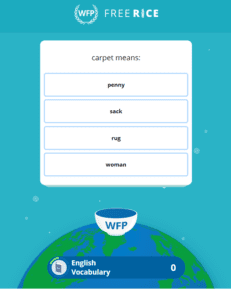
When we answer one question right on this website, they will donate one grain of rice to people in hunger all cross the world. I hope our future project can adapt a system like this. I would like my projects to focus on the themes of bettering our world, saving our environment and helping people in need. By presenting these values, these projects are truly meaningful. Targeted audience are those who not yet know much about a certain contemporary problem. We can raise awareness and open people’s eyes to things that they don’t usually observe about this world.